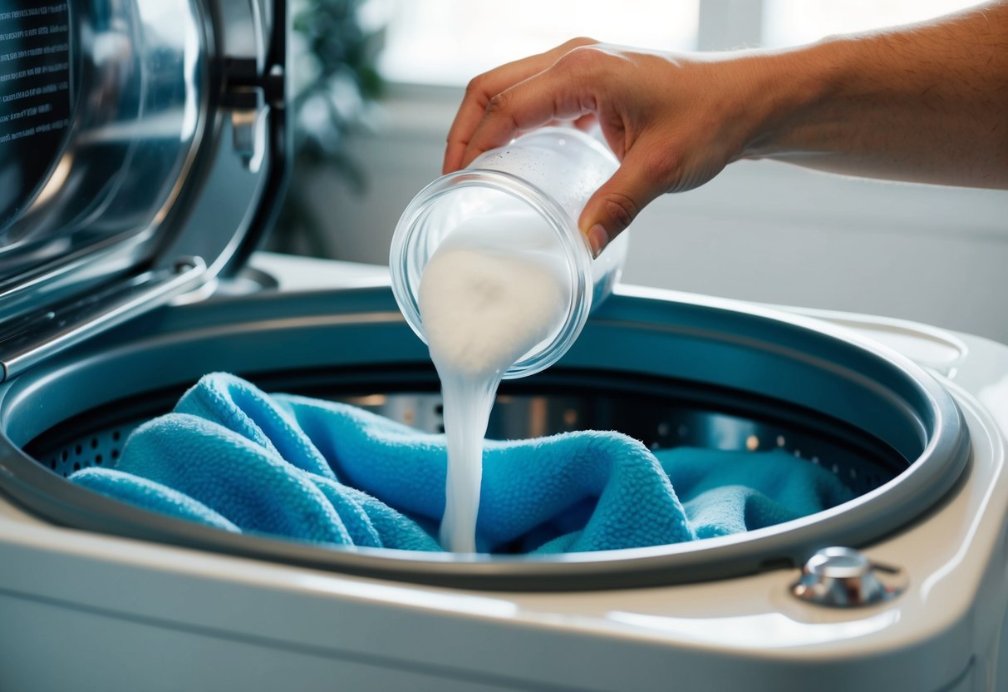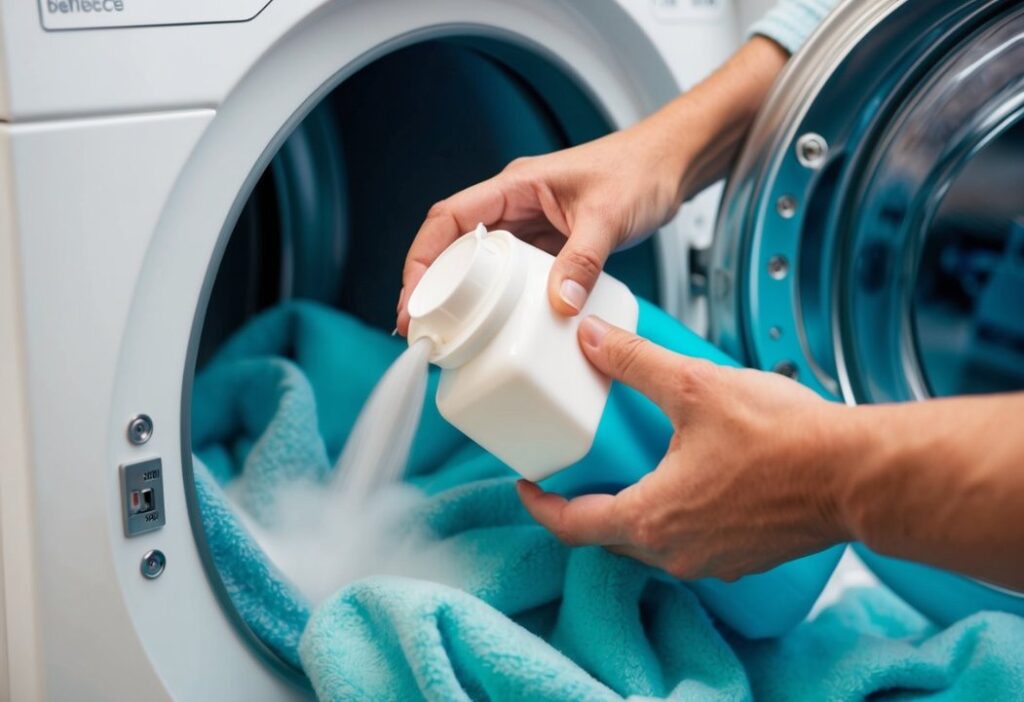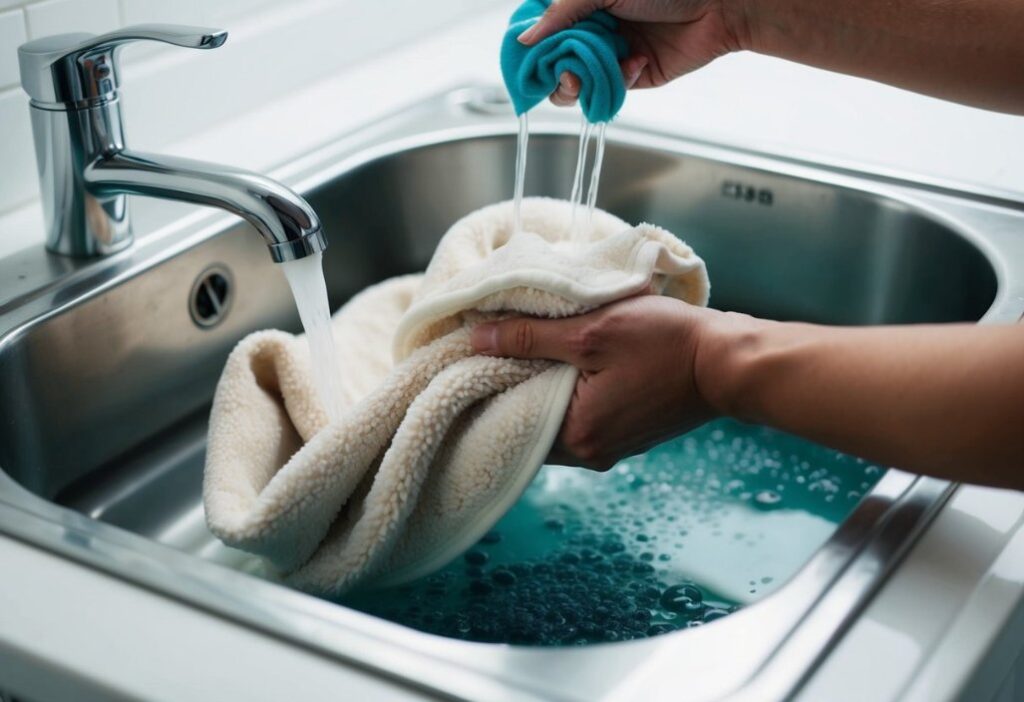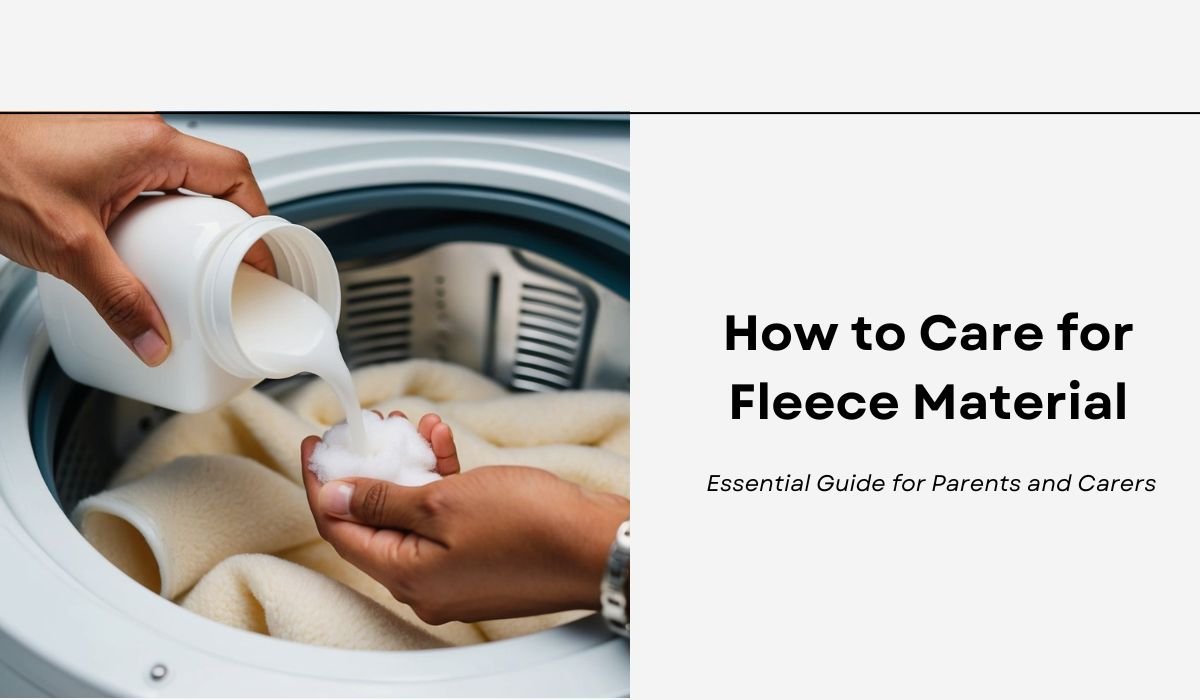Maximising Your Fleece’s Performance: Expert Care Guidelines for Preserving Warmth and Softness
Fleece is a cosy synthetic fabric that offers warmth without the weight of traditional wool. Made from polyester fibres, fleece gets its soft texture from a special brushing process called napping. This creates the fuzzy feel we love, but it also means the material needs specific care to stay in top condition.
Keeping fleece in prime condition requires washing it in cold water on a gentle cycle, avoiding fabric softeners, and air-drying to prevent damage to the fibres. The synthetic fibres can be sensitive to heat and friction, which means proper care techniques are essential for maintaining the material’s insulating properties and preventing pilling.
These lightweight garments provide excellent warmth and comfort when cared for properly. With the right maintenance, fleece items can stay soft and cosy for years, making them a reliable choice for cold-weather clothing.
On This Page
Key Takeaways
- Wash fleece in cold water without fabric softeners to maintain its insulating properties
- Air-dry fleece garments to prevent damage and preserve their fuzzy texture
- Store fleece items separately to avoid friction and pilling
Understanding Fleece Material
Fleece is a synthetic fabric made from polyester, not animal fur. Many manufacturers create fleece by recycling plastic bottles into polyester fibres, making it an eco-friendly choice.
The material goes through a special process called napping, where tiny brushes pull apart fibres to create its signature soft, fuzzy texture. This process gives fleece its warmth and cosiness.
Key Properties of Fleece:
- Lightweight yet warm
- Quick-drying
- Moisture-wicking
- Breathable
- Machine washable
Fleece comes in different weights and thicknesses. Lightweight fleece works well for exercise clothes, while thicker polar fleece suits cold-weather gear and blankets.
The material traps air between its fibres to provide excellent insulation. This makes fleece perfect for outdoor activities and winter clothing.
One unique aspect of fleece is its ability to maintain warmth even when damp. Unlike natural fibres like cotton, fleece continues to insulate when wet and dries quickly.
Pre-Wash Instructions for Fleece

The right preparation helps keep fleece soft and prevents damage during washing. Taking a few minutes to check labels and sort items makes a big difference in maintaining fleece’s quality.
Checking the Care Label
Care labels contain vital washing instructions that help maintain fleece’s quality. These labels specify the ideal water temperature, cycle settings and drying methods.
Look for symbols that indicate whether the fleece can be machine washed or requires hand washing. Some fleece garments need special care like cold water only or gentle cycle settings.
Pay attention to any warnings about bleach, fabric softeners, or heat exposure. These products can permanently damage fleece material.
Preparing Fleece for Washing
Turn fleece garments inside out before washing to protect the outer surface from friction damage. This helps prevent pilling and maintains the soft texture.
Empty all pockets and close any zips or buttons. Loose items can snag the fabric during washing.
Sort fleece items separately from towels and other linens to avoid lint transfer. Keep light and dark colours apart to prevent colour bleeding.
Check for any stains or spots that need pre-treatment. Use a gentle stain remover suitable for synthetic fabrics.
Washing Fleece Fabric

Proper washing techniques keep fleece soft and extend its lifespan. Cold or lukewarm water works best to maintain the fabric’s quality and prevent damage.
Choosing the Right Detergent
Mild detergents designed for delicate fabrics are essential for cleaning fleece. Regular washing powder can be too harsh and damage the fibres.
Avoid using fabric softeners as they can:
- Create a waxy coating
- Reduce the material’s warmth
- Decrease moisture-wicking properties
- Make the fabric less breathable
Use only half the normal amount of detergent to prevent soap build-up. Liquid detergents dissolve better in cold water compared to powder options.
Selecting the Correct Washing Cycle
A gentle or delicate cycle protects fleece from excessive agitation. Set the water temperature to cold or 30°C maximum.
Important cycle settings:
- Spin speed: Low to medium
- Water temperature: Cold to lukewarm
- Cycle length: Short to medium
Turn fleece garments inside out before washing to protect the outer surface. Separate light and dark colours to prevent dye transfer.
Machine Washing vs Hand Washing
Machine washing works well for most fleece items when using the correct settings. Front-loading machines are gentler on the fabric than top-loaders.
Hand washing steps:
- Fill a basin with cold water
- Add a small amount of mild detergent
- Gently rub the fabric for 5 minutes
- Rinse thoroughly with clean water
- Press out excess water – don’t wring or twist
Hand washing takes more time but offers more control over the cleaning process.
Drying and Shrinkage Prevention

Proper drying techniques are essential to keep fleece garments in top condition. Heat and friction damage fleece fibres, causing shrinkage and reducing the fabric’s soft texture.
Best Drying Practices
The most reliable method to dry fleece is to air dry the garments. Hang items on a sturdy clothes rack or line, away from direct sunlight to prevent colour fading.
Never wring or twist fleece items whilst wet. Instead, gently squeeze out excess water and lay flat to dry if the garment is heavy.
For quicker drying, use a clean white towel to roll up the fleece item and press gently. This helps absorb moisture without damaging the fabric’s structure.
Avoiding High Heat
High temperatures can permanently damage fleece, causing the fibres to melt or shrink. If using a tumble dryer is necessary, select the lowest heat setting available.
Check garments every 10-15 minutes when machine drying. Remove items whilst slightly damp to prevent over-drying and static build-up.
Tips for preventing shrinkage:
- Never use hot water for washing
- Avoid fabric softeners
- Remove promptly from dryer
- Choose air drying whenever possible
Maintaining Fleece’s Appearance

Proper maintenance keeps fleece soft and looking new. Regular care prevents common issues like pilling, static cling, and stains.
Dealing with Pilling
Small balls of fibre that form on fleece can make it look worn and old. Friction causes these pills to develop during normal wear and washing.
Use a fabric shaver or pill remover to gently remove the balls. Work in small sections and don’t press too hard to avoid damaging the material.
Wash fleece garments inside out to reduce friction. This simple step helps prevent new pills from forming.
Controlling Static Electricity
Static builds up easily in synthetic fleece, especially during cold, dry weather. A metal safety pin attached to the inside seam helps discharge static electricity.
Spray a small amount of anti-static spray on the inside of the garment before wearing. Don’t oversaturate the fabric.
Adding white vinegar to the rinse cycle when washing helps prevent static cling. Use 120ml of vinegar per normal wash load.
Removing Stains and Lint
Use enzymatic stain removers for tough spots. Apply the cleaner directly to the stain and let it sit for 5 minutes before washing.
A lint roller removes pet hair and dust quickly. Roll in short, firm strokes across the fabric surface.
For stubborn lint, use masking tape wrapped around your hand with the sticky side out. Press gently on problem areas.
Brush the fleece with a soft-bristled clothes brush after washing to restore its fuzzy texture.
Storing Fleece Items

Proper storage keeps fleece soft and extends its life. The right methods protect against pilling, stretching, and damage.
Folding vs Hanging
Fleece jackets and jumpers can be either folded or hung, but each method has specific benefits. Folding works best for lightweight fleece items to prevent stretching at the shoulders.
For hanging, use padded or wooden hangers rather than wire ones. Wire hangers can create bumps and stretched areas in the fabric.
Place folded items in drawers or on shelves with breathing room around them. Don’t stack too many pieces on top of each other, as this can compress the fibres.
Storing for Long-Term
Clean fleece thoroughly before long-term storage to prevent odours and stains from setting in. Use a gentle detergent and ensure items are completely dry.
Store fleece in breathable cotton storage bags or boxes. Avoid plastic containers which can trap moisture and lead to mildew.
Add cedar blocks or lavender sachets to storage containers. These natural solutions help repel moths and keep items fresh.
Keep storage areas cool, dry, and away from direct sunlight. Check stored items every few months for signs of damage or pests.
Guidelines for Fleece as a Winter Essential
Fleece stands as a vital winter clothing material thanks to its exceptional insulating properties. Fleece jackets provide warmth and comfort without adding bulk to winter outfits.
The material traps air between its fibres to create excellent insulation. This makes it perfect for layering during cold weather activities.
Key Benefits of Fleece:
- Lightweight yet warm
- Quick-drying capabilities
- Breathable material
- Easy to maintain
- Suitable for indoor and outdoor wear
Different types of fleece offer varying levels of warmth, with polar fleece being the most common for winter wear. The thickness of fleece is measured in grammes per square metre (GSM).
Recommended GSM for Different Weather:
| Weather Condition | GSM Range |
|---|---|
| Mild Winter Days | 100-200 |
| Cold Winter Days | 200-300 |
| Extreme Cold | 300+ |
For maximum warmth, people should wear fleece as a middle layer between a base layer and an outer shell. This creates the most effective insulation system for winter activities.
Environmental Considerations
Fleece garments come with distinct environmental effects that depend heavily on their source materials and care methods. The textile industry has made major advances in creating eco-friendly fleece options through innovative recycling processes.
Benefits of Recycled Fleece
Modern fleece manufacturers transform plastic bottles into high-quality fabrics. This reduces landfill waste and gives new life to existing materials.
Leading brands like Malden Mills use up to 25 recycled bottles to create a single fleece jacket. The process requires less energy than producing virgin polyester.
Recycled fleece maintains the same warmth and durability as traditional versions. The material performs especially well in cold, wet conditions whilst using fewer raw resources.
Caring for High-Performance Fleece
Proper washing techniques help minimise environmental impact. Cold water cycles at 30°C preserve the fabric structure and use less energy.
Essential Care Tips:
- Wash with similar materials to reduce microfibre shedding
- Skip the tumble dryer and air dry instead
- Use gentle, eco-friendly detergents
- Clean regularly to maintain breathability
Sustainable care practices extend the life of fleece garments. This reduces the need for replacement items and keeps synthetic materials out of landfills longer.
A quality fleece jacket can last 5+ years with proper maintenance. The extended lifespan offsets the initial environmental cost of production.
Frequently Asked Questions
Proper fleece care involves specific washing techniques, drying methods, and maintenance practices to keep the material soft and durable. The right cleaning approach makes a big difference in how long fleece items last.
How should one clean a fleece jacket by hand?
Fill a sink with cool water and add a gentle detergent. Gently squeeze the soapy water through the fleece without twisting or wringing.
Rinse thoroughly with clean, cool water until no soap remains. Press out excess water carefully without wringing the fabric.
What are the appropriate steps for washing fleece garments in a washing machine?
Turn the fleece garment inside out and zip up all zippers. Use cold water and the gentle cycle setting.
Skip fabric softeners as they can damage the material’s water-resistant properties. Wash with similar items to prevent friction damage.
What are some practical tips for maintaining the condition of fleece fabric?
Store fleece in cool, dry places to prevent moisture buildup and mildew. Fold items neatly rather than hanging them to maintain shape.
Brush the fabric periodically with a soft-bristled brush to remove surface debris and maintain its plush texture.
How can one ensure a fleece hoodie remains in optimal condition after washing?
Air dry the hoodie flat or use a dryer on low heat. Shape the garment while damp to prevent stretching or misshaping.
Keep the hood structured by laying it flat during drying. Avoid high heat which can damage the fibres.
In what ways can the longevity of fleece materials be increased?
Wash fleece items only when necessary to reduce wear. Remove stains promptly using spot cleaning rather than washing the entire garment.
Keep fleece away from rough surfaces that might cause pilling. Brush off dirt and debris instead of washing when possible.
Are there specific methods to clean fleece without compromising its quality?
Use specialised wool-free detergents designed for synthetic materials. Avoid bleach and harsh cleaning products.
Clean spills immediately with plain water and a clean cloth. For stubborn stains, use a mixture of gentle soap and cool water.
Related Posts:

